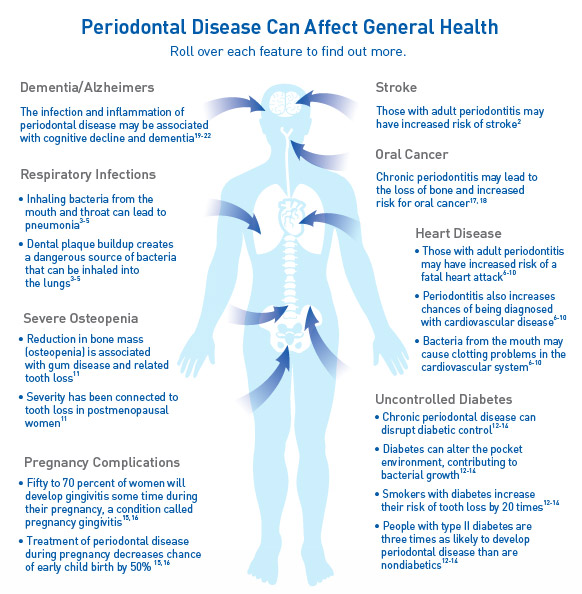Oral Health & The Body
Periodontal disease
is an infection of the supporting tissues of the teeth. Periodontitis, commonly referred to as gum disease or perio, always begins as inflammation of the gums (gingivitis), and then proceeds to the destructive stage of periodontitis.
Gingivitis:
Symptoms may present as swollen, sore gums, which may be red or puffy and may bleed while brushing. This stage is reversible.
Periodontitis:
Gums begin to detach from the teeth causing pockets, or spaces, around the teeth, as the plaque advances along the root. The body’s immune system initiates a chemical reaction that causes the destruction of the periodontal attachment to the teeth, and eventually destroys the bone supporting the teeth.
Good oral health is crucial for good overall health.
Periodontal disease can be prevented, and even reversed in the early stages, by keeping teeth and gums clean and healthy.
-
Brush teeth twice a day
-
Use a soft-bristled toothbrush.
-
Power toothbrushes help to effectively clean hard-to-clean areas such as large spaces between teeth, around dental work and around orthodontics.
-
Use toothpaste and mouth rinses that contain fluoride to strengthen the teeth and prevent decay.
-
Clean between teeth each day
-
Use floss or interdental cleaners to reduce bacteria and plaque that builds up in the tight spaces between teeth
-
Use a tongue cleaner each day to remove bacteria
-
Eat a balanced diet
-
Visit a dentist regularly
Reduce or eliminate activities that may cause periodontal disease
- Steroids
- Tobacco use
- Alcohol abuse
For additional information, visit the American Dental Association.
Statistics and Facts
Periodontal disease affects more than 80 percent of adults in the U.S. population, and it may not present any noticeable symptoms. It is a major cause of tooth loss in adults.
Progression of Untreated Periodontal Disease

The disease starts when a bacteria-rich, sticky biofilm called plaque builds up on teeth. If the plaque remains untreated, it will turn into calculus (tartar) that can only be removed by a dental professional. This plaque buildup eventually results in pockets, a feature caused by gums detaching from the teeth. This allows more plaque and bacteria to reach further into the tissues and cause infection.
Infection may lead to more pain (often there is NO pain), swelling of the gums and damage to the gums, tooth roots and bone. The longer the disease goes untreated, the deeper the pocket will grow, and the bone that surrounds the tooth will resorb or melt and create craters, with eventual loosening of the teeth.
Symptoms of periodontal disease include:
-
Red, swollen or tender gums
-
Persistent bad breath
-
Sore and/or bleeding gums
-
Sensitive teeth
-
Gums that are detaching from the teeth causing pockets
-
Pain when chewing
-
Loose teeth
Risk Factors for Periodontal Disease
-
Tobacco use, including cigars, cigarettes and chewing tobacco
-
Alcohol abuse
-
Genetics
-
Systemic diseases such as diabetes
-
Crooked and overlapping teeth
-
Fillings that have deteriorated or become defective
-
Pregnancy
-
Stress
-
Some types of medications such as steroids, some types of anti-epilepsy drugs, cancer therapy drugs, some calcium channel blockers, sex hormones and oral contraceptives
The effects of periodontal disease reach far beyond the oral cavity. Increasing evidence indicates that periodontal disease may be linked to systemic disease.
Additional Resources
American Academy of Periodontology
The American Academy of Periodontology (AAP) is a professional association for dental professionals who specialize in the prevention, diagnosis and treatment of diseases affecting the gums and supporting structures of the teeth.
National Institute of Dental and Craniofacial Research
The mission of the National Institute of Dental and Craniofacial Research (NIDCR) is to improve oral, dental and craniofacial health through research, research training and the dissemination of health information. They are part of the U.S. government’s National Institutes of Health.
Centers for Disease Control and Prevention
For more than 60 years, CDC has been dedicated to protecting health and promoting quality of life through the prevention and control of disease, injury and disability. This U.S. government organization works to reduce the health and economic consequences of the leading causes of death and disability, thereby ensuring a long, productive, healthy life for all people.
American Dental Association and their consumer site MouthHealthy.org
Founded in 1859, the American Dental Association (ADA) is the oldest and largest national dental society in the world. Since then, the ADA has grown to become a leading source of oral-health related information for dentists and their patients.


